船舶专业英语(课文+翻译)
- 格式:doc
- 大小:137.41 KB
- 文档页数:75
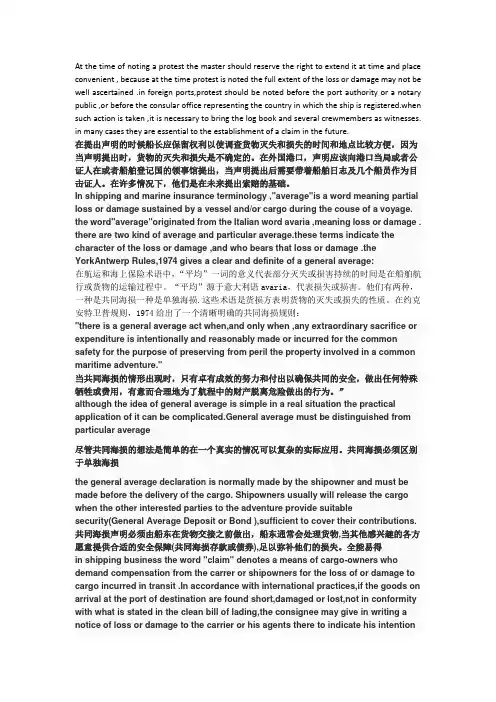
At the time of noting a protest the master should reserve the right to extend it at time and place convenient , because at the time protest is noted the full extent of the loss or damage may not be well ascertained .in foreign ports,protest should be noted before the port authority or a notary public ,or before the consular office representing the country in which the ship is registered.when such action is taken ,it is necessary to bring the log book and several crewmembers as witnesses. in many cases they are essential to the establishment of a claim in the future.在提出声明的时候船长应保留权利以使调查货物灭失和损失的时间和地点比较方便,因为当声明提出时,货物的灭失和损失是不确定的。
在外国港口,声明应该向港口当局或者公证人在或者船舶登记国的领事馆提出,当声明提出后需要带着船舶日志及几个船员作为目击证人。
在许多情况下,他们是在未来提出索赔的基础。
In shipping and marine insurance terminology ,"average"is a word meaning partial loss or damage sustained by a vessel and/or cargo during the couse of a voyage. the word"average"originated from the Italian word avaria ,meaning loss or damage . there are two kind of average and particular average.these terms indicate the character of the loss or damage ,and who bears that loss or damage .the YorkAntwerp Rules,1974 gives a clear and definite of a general average:在航运和海上保险术语中,“平均”一词的意义代表部分灭失或损害持续的时间是在船舶航行或货物的运输过程中。
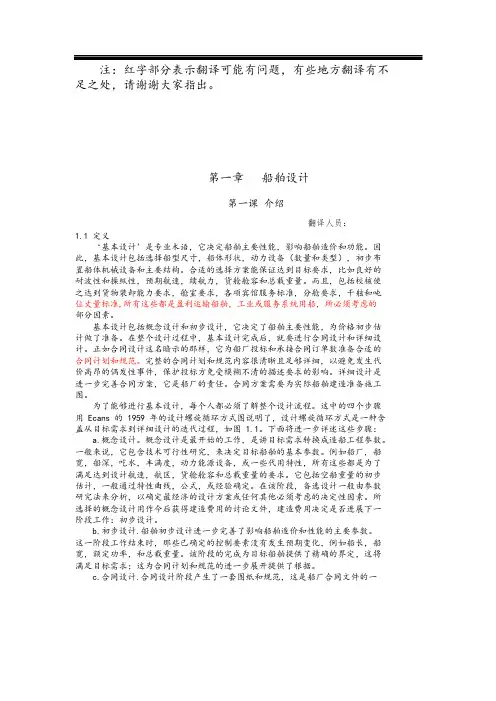
注:红字部分表示翻译可能有问题,有些地方翻译有不足之处,请谢谢大家指出。
第一章船舶设计第一课介绍翻译人员:1.1 定义‘基本设计’是专业术语,它决定船舶主要性能,影响船舶造价和功能。
因此,基本设计包括选择船型尺寸,船体形状,动力设备(数量和类型),初步布置船体机械设备和主要结构。
合适的选择方案能保证达到目标要求,比如良好的耐波性和操纵性,预期航速,续航力,货舱舱容和总载重量。
而且,包括校核使之达到货物装卸能力要求,舱室要求,各项宾馆服务标准,分舱要求,干舷和吨位丈量标准,所有这些都是盈利运输船舶,工业或服务系统用船,所必须考虑的部分因素。
基本设计包括概念设计和初步设计,它决定了船舶主要性能,为价格初步估计做了准备。
在整个设计过程中,基本设计完成后,就要进行合同设计和详细设计。
正如合同设计这名暗示的那样,它为船厂投标和承接合同订单数准备合适的合同计划和规范。
完整的合同计划和规范内容很清晰且足够详细,以避免发生代价高昂的偶发性事件,保护投标方免受模糊不清的描述要求的影响。
详细设计是进一步完善合同方案,它是船厂的责任。
合同方案需要为实际船舶建造准备施工图。
为了能够进行基本设计,每个人都必须了解整个设计流程。
这中的四个步骤用 Ecans 的 1959 年的设计螺旋循环方式图说明了,设计螺旋循环方式是一种含盖从目标需求到详细设计的迭代过程,如图 1.1。
下面将进一步详述这些步骤: a.概念设计。
概念设计是最开始的工作,是讲目标需求转换成造船工程参数。
一般来说,它包含技术可行性研究,来决定目标船舶的基本参数。
例如船厂,船宽,船深,吃水,丰满度,动力能源设备,或一些代用特性,所有这些都是为了满足达到设计航速,航区,货舱舱容和总载重量的要求。
它包括空船重量的初步估计,一般通过特性曲线,公式,或经验确定。
在该阶段,备选设计一般由参数研究法来分析,以确定最经济的设计方案或任何其他必须考虑的决定性因素。
所选择的概念设计用作今后获得建造费用的讨论文件,建造费用决定是否进展下一阶段工作:初步设计。
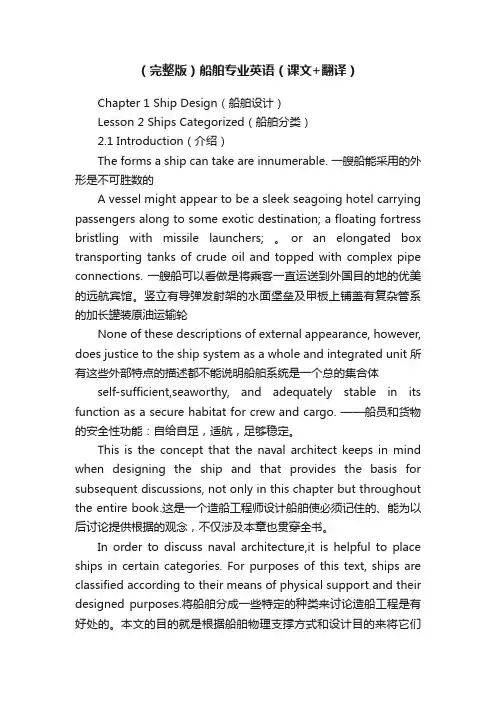
(完整版)船舶专业英语(课文+翻译)Chapter 1 Ship Design(船舶设计)Lesson 2 Ships Categorized(船舶分类)2.1 Introduction(介绍)The forms a ship can take are innumerable. 一艘船能采用的外形是不可胜数的A vessel might appear to be a sleek seagoing hotel carrying passengers along to some exotic destination; a floating fortress bristling with missile launchers; 。
or an elongated box transporting tanks of crude oil and topped with complex pipe connections. 一艘船可以看做是将乘客一直运送到外国目的地的优美的远航宾馆。
竖立有导弹发射架的水面堡垒及甲板上铺盖有复杂管系的加长罐装原油运输轮None of these descriptions of external appearance, however, does justice to the ship system as a whole and integrated unit所有这些外部特点的描述都不能说明船舶系统是一个总的集合体self-sufficient,seaworthy, and adequately stable in its function as a secure habitat for crew and cargo. ——船员和货物的安全性功能:自给自足,适航,足够稳定。
This is the concept that the naval architect keeps in mind when designing the ship and that provides the basis for subsequent discussions, not only in this chapter but throughout the entire book.这是一个造船工程师设计船舶使必须记住的、能为以后讨论提供根据的观念,不仅涉及本章也贯穿全书。

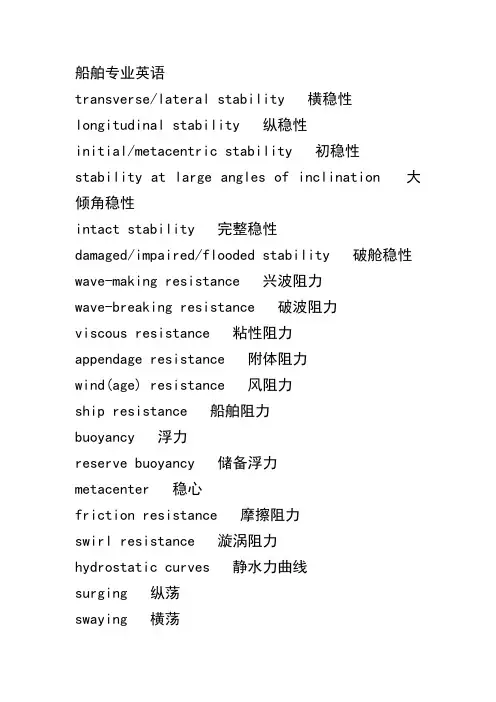
船舶专业英语transverse/lateral stability 横稳性longitudinalstability纵稳性initial/metacentricstability初稳性stabilityat large angles of inclination 大倾角稳性intact stability完整稳性damaged/impaired/floodedstability破舱稳性wave-makingresistance兴波阻力wave-breakingresistance破波阻力viscousresistance粘性阻力appendageresistance附体阻力wind(age) resistance风阻力shipresistance船舶阻力buoyancy浮力reservebuoyancy储备浮力metacenter稳心frictionresistance摩擦阻力swirlresistance漩涡阻力hydrostaticcurves静水力曲线surging纵荡swaying横荡heaving垂荡,升沉rolling横摇pitching纵摇yawing垂摇,首摇headsea(345-15degrees)顶浪,迎浪bow sea(15-75,285-345)艏斜浪athwartsea(75-105,255-285)横浪quartingsea(105-165,195-255)艉斜浪sternsea(165-195 degrees)尾浪enginepower主机功率bulbousbow球鼻首ratedhorsepower额定马力effectivehorsepower有效马力floatability浮性stability稳性fastspeed快速性floodability抗沉性maneuverability操纵性shiprouting航线seakeeping耐波性insubmersibility 不沉性rapidity快速性endurance续航性coursekeeping航向保持性sea-worthiness 适航性propulsionplant推进装置rollperiod横摇周期initialmetacentricheight初稳性高度stabilizingunit减摇装置wingbuoyanttank减摇水舱directionalstability航向稳定性turningability回转性能load-linemark载重线标志turningcircle回转半径steeringgear操舵装置rudder舵static forces 静水力stillwater静水staticlongitudinalstrength静态总纵强度shearingforce剪切力bendingmoment弯矩shipdesign船舶设计deadweight载重量draught吃水blockcoefficient方形系数lengthofthe ship 船长breadthofthe ship 船宽lengthbetweenperpendiculars垂线间长grossdisplacementtonnage总排水量lengthoverall总长afterballasttank尾压载舱freshwatertank淡水舱steeringgearroom舵机舱fueltank燃油舱lube rank 滑油舱cofferdam隔离舱voidspace空舱seachest海水舱shafttunnel轴隧。
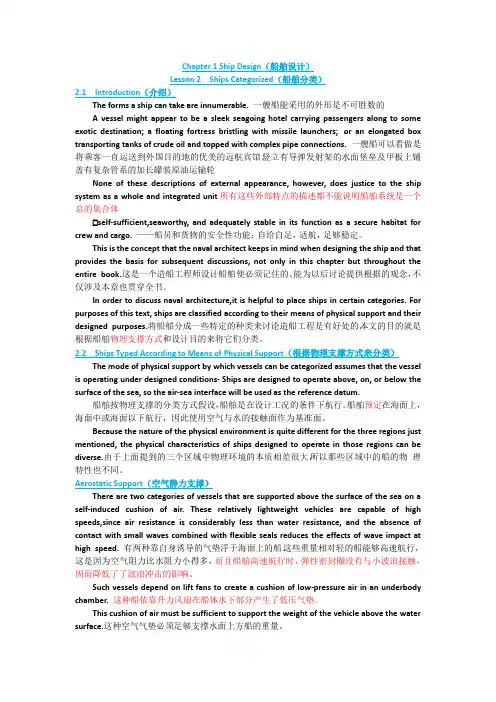
Chapter 1 Ship Design(船舶设计)Lesson 2 Ships Categorized(船舶分类)2.1 Introduction(介绍)The forms a ship can take are innumerable. 一艘船能采用的外形是不可胜数的A vessel might appear to be a sleek seagoing hotel carrying passengers along to some exotic destination; a floating fortress bristling with missile launchers; 。
or an elongated box transporting tanks of crude oil and topped with complex pipe connections. 一艘船可以看做是将乘客一直运送到外国目的地的优美的远航宾馆。
竖立有导弹发射架的水面堡垒及甲板上铺盖有复杂管系的加长罐装原油运输轮None of these descriptions of external appearance, however, does justice to the ship system as a whole and integrated unit所有这些外部特点的描述都不能说明船舶系统是一个总的集合体self-sufficient,seaworthy, and adequately stable in its function as a secure habitat for crew and cargo. ——船员和货物的安全性功能:自给自足,适航,足够稳定。
This is the concept that the naval architect keeps in mind when designing the ship and that provides the basis for subsequent discussions, not only in this chapter but throughout the entire book.这是一个造船工程师设计船舶使必须记住的、能为以后讨论提供根据的观念,不仅涉及本章也贯穿全书。
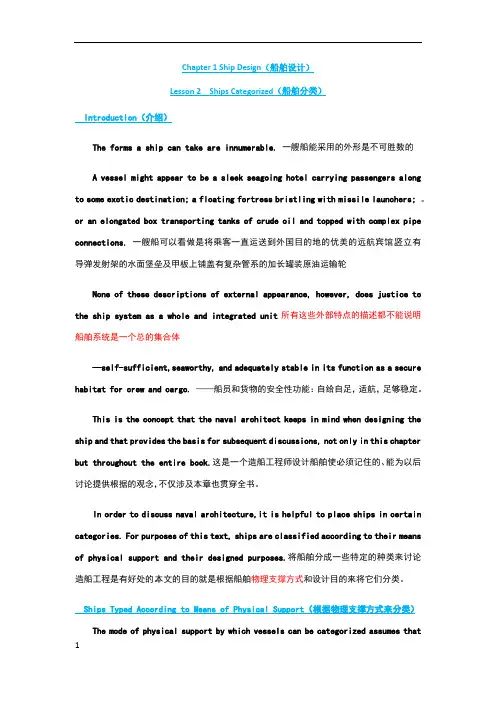
Chapter 1 Ship Design(船舶设计)Lesson 2 Ships Categorized(船舶分类)Introduction(介绍)The forms a ship can take are innumerable. 一艘船能采用的外形是不可胜数的A vessel might appear to be a sleek seagoing hotel carrying passengers along to some exotic destination; a floating fortress bristling with missile launchers; 。
or an elongated box transporting tanks of crude oil and topped with complex pipe connections. 一艘船可以看做是将乘客一直运送到外国目的地的优美的远航宾馆。
竖立有导弹发射架的水面堡垒及甲板上铺盖有复杂管系的加长罐装原油运输轮None of these descriptions of external appearance, however, does justice to the ship system as a whole and integrated unit所有这些外部特点的描述都不能说明船舶系统是一个总的集合体—self-sufficient,seaworthy, and adequately stable in its function as a secure habitat for crew and cargo. ——船员和货物的安全性功能:自给自足,适航,足够稳定。
This is the concept that the naval architect keeps in mind when designing the ship and that provides the basis for subsequent discussions, not only in this chapter but throughout the entire book.这是一个造船工程师设计船舶使必须记住的、能为以后讨论提供根据的观念,不仅涉及本章也贯穿全书。
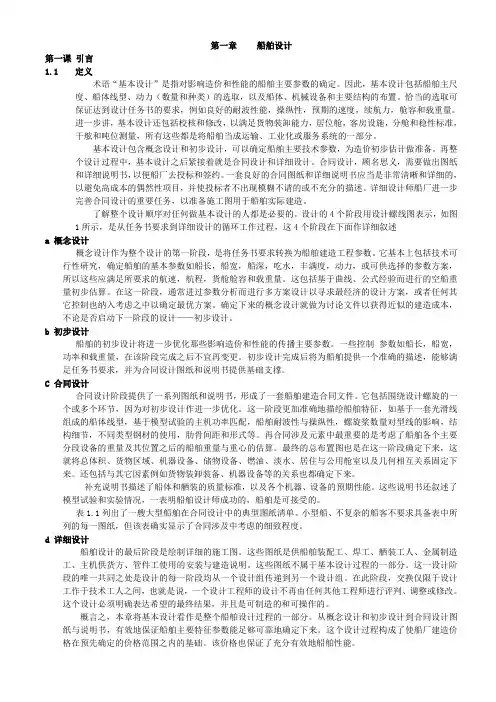
第一章船舶设计第一课引言1.1定义术语“基本设计”是指对影响造价和性能的船舶主要参数的确定。
因此,基本设计包括船舶主尺度、船体线型、动力(数量和种类)的选取,以及船体、机械设备和主要结构的布置。
恰当的选取可保证达到设计任务书的要求,例如良好的耐波性能,操纵性,预期的速度,续航力,舱容和载重量。
进一步讲,基本设计还包括校核和修改,以满足货物装卸能力,居位舱,客房设施,分舱和稳性标准,干舷和吨位测量,所有这些都是将船舶当成运输、工业化或服务系统的一部分。
基本设计包含概念设计和初步设计,可以确定船舶主要技术参数,为造价初步估计做准备。
再整个设计过程中,基本设计之后紧接着就是合同设计和详细设计。
合同设计,顾名思义,需要做出图纸和详细说明书,以便船厂去投标和签约。
一套良好的合同图纸和详细说明书应当是非常清晰和详细的,以避免高成本的偶然性项目,并使投标者不出现模糊不请的或不充分的描述。
详细设计师船厂进一步完善合同设计的重要任务,以准备施工图用于船舶实际建造。
了解整个设计顺序对任何做基本设计的人都是必要的。
设计的4个阶段用设计螺线图表示,如图1所示,是从任务书要求到详细设计的循环工作过程,这4个阶段在下面作详细叙述a 概念设计概念设计作为整个设计的第一阶段,是将任务书要求转换为船舶建造工程参数。
它基本上包括技术可行性研究,确定船舶的基本参数如船长,船宽,船深,吃水,丰满度,动力,或可供选择的参数方案,所以这些应满足所要求的航速,航程,货舱舱容和载重量。
这包括基于曲线、公式经验而进行的空船重量初步估算。
在这一阶段,通常进过参数分析而进行多方案设计以寻求最经济的设计方案,或者任何其它控制也纳入考虑之中以确定最优方案。
确定下来的概念设计就做为讨论文件以获得近似的建造成本,不论是否启动下一阶段的设计——初步设计。
b 初步设计船舶的初步设计将进一步优化那些影响造价和性能的传播主要参数。
一些控制参数如船长,船宽,功率和载重量,在该阶段完成之后不宜再变更。
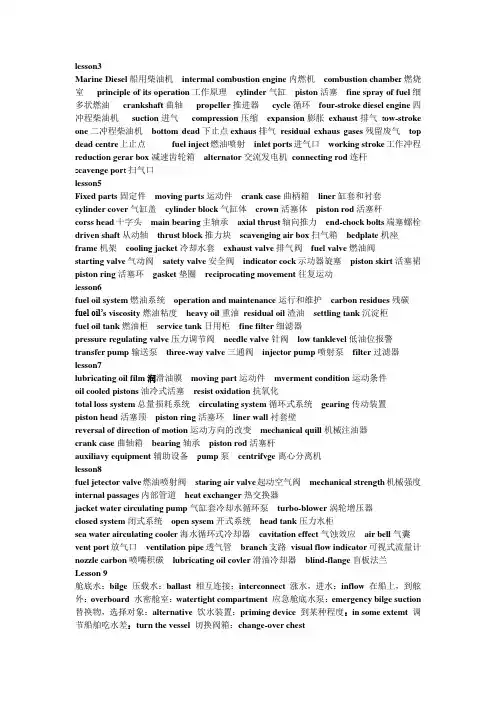
lesson3Marine Diesel船用柴油机intermal combustion engine内燃机combustion chambe r燃烧室principle of its operation工作原理cylinder气缸piston活塞fine spray of fuel细多状燃油crankshaft曲轴propeller推进器cycle循环four-stroke diesel engine四冲程柴油机suction进气compression压缩expansion膨胀exhaust排气t ow-stroke one二冲程柴油机bottom dead下止点exhaus排气residual exhaus gases残留废气top dead centre上止点fuel inject燃油喷射inlet ports进气口working stroke工作冲程reduction gerar box减速齿轮箱alternator交流发电机connecting rod连杆s cavenge por t扫气口lesson5Fixed parts固定件moving parts运动件crank case曲柄箱liner缸套和衬套cylinder cover气缸盖cylinder block气缸体crown活塞体piston rod活塞杆corss head十字头main bearin g主轴承axial thrust轴向推力end-chock bolts端塞螺栓driven shaft从动轴thrust block推力块scavenging air box扫气箱bedplate机座frame机架cooling jacket冷却水套exhaust valve排气阀fuel valve燃油阀starting valve气动阀satety valve安全阀indicator cock示功器旋塞piston skirt活塞裙piston ring活塞环gasket垫圈reciprocating movement往复运动l esson6fuel oil system燃油系统operation and maintenance运行和维护carbon residues残碳fuel oil’s viscosity燃油粘度heavy oil重油residual oil渣油settling tank沉淀柜fuel oil tank燃油柜service tank日用柜fine filter细滤器pressure regulating valve压力调节阀needle valve针阀low tanklevel低油位报警transfer pump输送泵three-way valve三通阀injector pump喷射泵filter过滤器lesson7lubricating oil film润滑油膜moving part运动件mverment condition运动条件oil cooled pistons油冷式活塞resist oxidation抗氧化total loss system总量损耗系统circulating system循环式系统gearing传动装置piston head活塞顶piston ring活塞环liner wall衬套壁reversal of direction of motion运动方向的改变mechanical quill机械注油器crank case曲轴箱bearing轴承piston rod活塞杆auxiliavy equipment辅助设备p ump泵centrifvge离心分离机lesson8fuel jetector valve燃油喷射阀staring air valve起动空气阀mechanical strength机械强度internal passages内部管道heat exchanger热交换器jacket water circulating pump气缸套冷却水循环泵turbo-blower涡轮增压器closed system闭式系统open sysem开式系统head tank压力水柜sea water airculating cooler海水循环式冷却器cavitation effect气蚀效应air bell气囊vent port放气口ventilation pipe透气管branch支路visual flow indicator可视式流量计nozzle carbon喷嘴积碳lubricating oil covler滑油冷却器blind-flange盲板法兰Lesson 9舱底水:bilge 压载水:ballast相互连接:interconnect涨水,进水:inflow在船上,到舷外:overboard水密舱室:watertight compartment 应急舱底水泵:emergency bilge suction 替换物,选择对象:alternative 饮水装置:priming device到某种程度:in some extemt 调节船舶吃水差:turn the vessel切换阀箱:change-over chestLesson 11容积式泵:displatement pump离心泵:centrifugal pump往复泵:reciprocating pump叶片泵:vane pump齿轮泵:gear pump旋转泵:rotary pump离心力:centrifugal fore轴向的:axial涡轮,涡轮机:turbine自吸式:self-priming 啮合齿轮:meshing gears蒸汽喷射器:steam ejector 舵机液压系统:steering gear hydraulic system 人字齿:double helical teech大气压:atmospheric pressure 立式泵:vertical pumpLesson 13甲板机械:deck machinery克令吊:crane 日常检验:rountine checking锚泊设备:anchor arrangement集装箱吊装设备厂:锚链管:chain pipe原动机:generator装卸能力:cargo handling productivity多旋转吊杆系统:multiwinch slewing derrick system 绞车卷筒:winch end 吊杆式起货装置:derrick cargo rig安全负载:safe working loadLesson31.The diesel engine is type of internal combustion engine which ignites the fuel by injecting it into hot ,high pressure air in a combustion chamber柴油机是一种内燃机,它是通过将燃油喷射到具有高温高压气体的燃烧室从而点燃燃油。
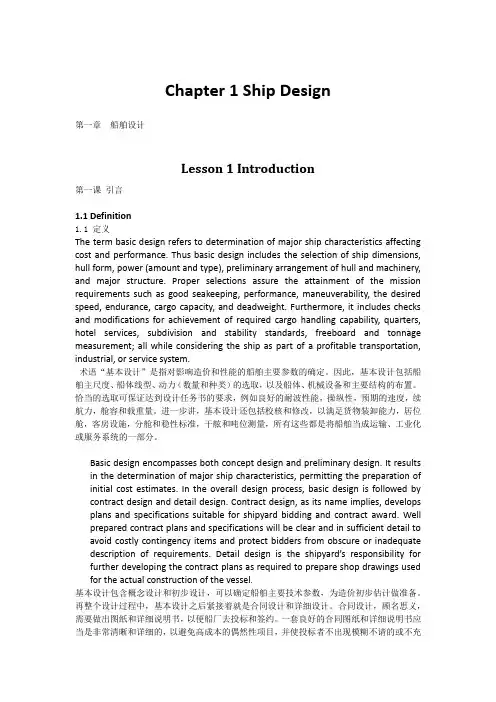
Chapter 1 Ship Design第一章船舶设计Lesson 1 Introduction第一课引言1.1Definition1.1 定义The term basic design refers to determination of major ship characteristics affecting cost and performance. Thus basic design includes the selection of ship dimensions, hull form, power (amount and type), preliminary arrangement of hull and machinery, and major structure. Proper selections assure the attainment of the mission requirements such as good seakeeping, performance, maneuverability, the desired speed, endurance, cargo capacity, and deadweight. Furthermore, it includes checks and modifications for achievement of required cargo handling capability, quarters, hotel services, subdivision and stability standards, freeboard and tonnage measurement; all while considering the ship as part of a profitable transportation, industrial, or service system.术语“基本设计”是指对影响造价和性能的船舶主要参数的确定。
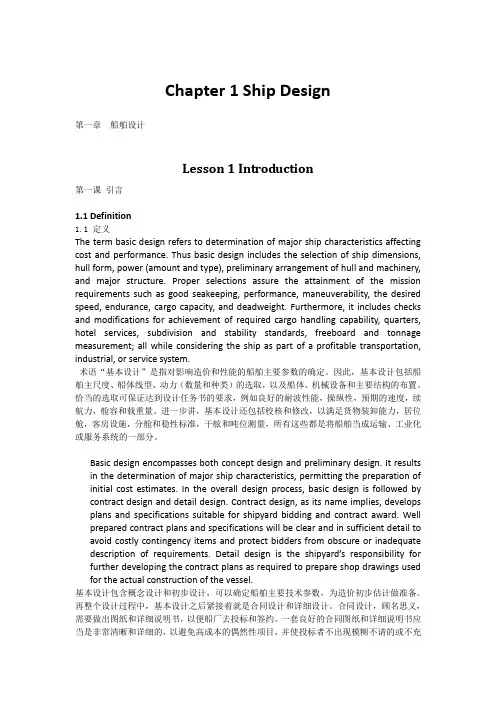
Chapter 1 Ship Design第一章船舶设计Lesson 1 Introduction第一课引言1.1Definition1.1 定义The term basic design refers to determination of major ship characteristics affecting cost and performance. Thus basic design includes the selection of ship dimensions, hull form, power (amount and type), preliminary arrangement of hull and machinery, and major structure. Proper selections assure the attainment of the mission requirements such as good seakeeping, performance, maneuverability, the desired speed, endurance, cargo capacity, and deadweight. Furthermore, it includes checks and modifications for achievement of required cargo handling capability, quarters, hotel services, subdivision and stability standards, freeboard and tonnage measurement; all while considering the ship as part of a profitable transportation, industrial, or service system.术语“基本设计”是指对影响造价和性能的船舶主要参数的确定。
(2349---2690)2349你船靠泊船首在码头并没有拖轮协助。
哪一根缆绳最有用当你操纵船舶靠泊时?首倒缆2350 你船装载不吸湿的货物自寒冷地区到温暖地区。
你应货舱不通风。
2351你船因为GM高度不足导致倾斜。
为降低G在M之下,你应在G下对称地增加重量。
2352 你船左倾4度且横摇周期短。
船壳内有自由流动灭火留下的水。
船舶首倾且首干舷1英尺。
你应最先采取什么措施?排出首尖舱的水2353 你船装载吸湿的货物自温暖地区开往寒冷地区。
哪一句是正确的?你必须连续且旺盛地通风以防止船体出汗2354你船的机舱在船中部并且货物集中装在船的首尾部。
船舶有拉伸主甲板的中拱。
2355 油船满载,并且你发现尾倾过大。
为调整吃水差,你可以转移燃油到船首部。
2356油船满载,并且你发现有轻微的首倾。
为调整吃水差,你可以转移货油到船尾部。
2357 你船装载危险货物。
在日常检查中,你注意到几个箱子的货物移位并开裂。
你首先应立即将情况报告船长并听候指示。
2358你最好把选港货装在二层舱的防堵舱位,这样无论在上海或大连都能够被轻易卸出。
2359你将在常温下装载散装硫磺。
哪一句是正确的?散装硫磺可以被符合所有适用规则而没有特别允许的船舶装载2360 你装运的货物中有一含有一类爆炸品的包裹。
包裹潮湿,发霉和污黑。
根据规则装运这个包裹你应联系托运人并建议撤回,修理或更换。
2361 你很可能移动重量自上二层舱到底舱。
这样一来,船舶将有更大的稳性高度。
2362 你已靠泊在周围有油船的码头。
什么信号表示船舶正在进行转移易燃或可燃液体货物?视野周围可见到一盏红灯2363 你有一定数量的袋装货物装载在三个甲板下二层舱。
哪一种堆装方式最稳定?分层换向堆码2364你们不能完成二舱的装货,能够吗?在肯定句中,用hardly,scarcely等词表示否定时,反意疑问句用肯定动词反问。
2365 在卸货其间,请求你安排必要的理货员在船上进行理货工作。
中英文资料外文翻译文献A Simple Prediction Formula of Roll Damping of Conventional Cargo Ships on the Basis of lkeda's Method and Its LimitationSince the roll damping of ships has significant effects of viscosity, it is difficult to calculate it theoretically. Therefore, experimental results or some prediction methods are used to get the roll damping in design stage of ships. Among some prediction methods, Ikeda’s one is widely used in many ship motion computer programs. Using the method, the roll damping of various ship hulls with various bilge keels can be calculated to investigate its characteristics. To calculate the roil damping of each ship, detailed data of the ship are needed to input. Therefore, a simpler prediction method is expected in primary design stage. Such a simple method must be useful to validate the results obtained by a computer code to predict it on the basis of Ikeda,s method, too. On the basis of the predicted roll damping by Ikeda’s method for various ships, a very simple prediction formula of the roll damping of ships is deduced in the present paper. Ship hull forms are systematically changed by changing length, beam, draft, mid-ship sectional coefficient and prismatic coefficient. It is found, however, that this simple formula can not be used for ships that have high position of the center of gravity. A modified method to improve accuracy for such ships is proposed.Key words: Roll damping, simple prediction formula, wave component, eddy component, bilge keel component.IntroductionIn 1970s, strip methods for predicting ship motions in 5-degree of freedoms in waves have been established. The methods are based on potential flow theories (Ursell-Tasai method, source distribution method and so on), and can predict pitch, heave, sway and yaw motions of ships in waves in fairly good accuracy. In roll motion, however, the strip methods do not work well because of significant viscous effects on the roll damping. Therefore, some empirical formulas or experimental dataare used to predict the roll damping in the strip methods.To improve the prediction of roll motions by these strip methods, one of the authors carried out a research project to develop a roll damping prediction method which has the same concept and the same order of accuracy as the strip methods which are based on hydrodynamic forces acting on strips. The review of the prediction method was made by Himeno [5] and Ikeda [6,7] with the computer program.The prediction method, which is now called Ikeda’s method, divides the roll damping into the frictional (BF), the wave (Bw),the eddy (Be) and the bilge keel (Bbk) components at zero forward speed, and at forward speed, the lift (Bi) is added. Increases of wave and friction components due to advance speed are also corrected on the basis of experimental results. Then the roll damping coefficient B44 (= roll damping moment (kgfm)/roll angular velocity (rad/sec)) can be expressed as follows: B44 B bk (1)At zero forward speed, each component except the friction and lift components are predicted for each cross section with unit length and the predicted values are summed up along the ship length. The friction component is predicted by Kato’s formula for a three-dimensional ship shape. Modification functions for predicting the forward speed effects on the roll damping components are developed for the friction, wave and eddy components. The computer program of the method was published, and the method has been widely used.For these 30 years, the original Ikeda’s method developed for conven tional cargo ships has been improved to apply many kinds of ships, for examples, more slender and round ships, fishing boats, barges, ships with skegs and so on. The original method is also widely used. However, sometimes, different conclusions of roll mot ions were derived even though the same Ikeda’s method was used in the calculations. Then, to check the accuracy of the computer programs of the same Ikeda’s method, a more simple prediction method with the almost same accuracy as the Ikeda’s original one h as been expected to be developed. It is said that in design stages of ships, Ikeda’s method is too complicated to use. To meet these needs, a simple roll damping prediction method was deduced by using regression analysis [8].Previous Prediction FormulaThe simple prediction formula proposed in previous paper can not be used for modem ships that have high position of center of gravity or long natural roll period such as large passenger ships with relatively flat hull shape. In order to investigate its limitation, the authors compared the result of this prediction method with original Ikeda’s one while out of its calculating limitation. Fig. 1 shows the result of the comparison with their method of roll damping. The upper one is on the condition that the center of gravity is low and the lower one on the condition that the center of gravity is high.From this figure, the roll damping estimated by this prediction formula is in good agreement with the roll damping calculated by the Ikeda’s method for low positi on of center of gravity, but the error margin grows for the high position of center of gravity. The results suggest that the previous prediction formula is necessary to be revised. Methodical Series ShipsModified prediction formula will be developed on the basis of the predicted results by Ikeda’s method using the methodical series ships. This series ships are constructed based on the Taylor Standard Series and its hull shapes are methodically changed by changing length, beam, draft, midship sectional coefficient and longitudinal prismatic coefficient. The geometries of the series ships are given by the following equations. Proposal of New Prediction Method of Roll DampingIn this chapter, the characteristics of each component of the roll damping, the frictional, the wave, the eddy and the bilge keel components at zero advanced speed, are discussed, and a simple prediction formula of each component is developed.As well known, the wave component of the roll damping for a two-dimensional cross section can be calculated by potential flow theories in fairly good accuracy. In Ikeda's method, the wave damping of a strip section is not calculated and the calculated values by any potential flow theories are used as the wave damping.reason why viscous effects are significant in only roll damping can be explained as follows. Fig. 4 shows the wave component of the roll damping for 2-D sections calculated by a potential flow theory.ConclusionsA simple prediction method of the roll damping of ships is developed on the basis of the Ikeda’s original prediction method which was developed in the same concept as a strip method for calculating ship motions in waves. Using the data of a ship, B/d, Cb,Cm, OG/d, G),bBK/B, Ibk/Lpp,(pa, the roll damping of a ship can be approx imately predicted. Moreover, the limit of application of Ikeda’s prediction method to modern ships that have buttock flow stern is demonstrated by the model experiment. The computer program of the method can be downloaded from the Home Page of Ikeda’s Labo (AcknowledgmentsThis work was supported by the Grant-in Aid for Scientific Research of the Japan Society for Promotion of Science (No. 18360415).The authors wish to express sincere appreciation to Prof. N. Umeda of Osaka University for valuable suggestions to this study.References五、Y. Ikeda, Y. Himeno, N. Tanaka, On roll damping force of shipEffects of friction of hull and normal force of bilge keels, Journal of the Kansai Society of Naval Architects 161 (1976) 41-49. (in Japanese)六、Y. Ikeda, K. Komatsu, Y. Himeno, N. Tanaka, On roll damping force of ship~Effects of hull surface pressure created by bilge keels, Journal of the Kansai Society of Naval Architects 165 (1977) 31-40. (in Japanese)七、Y. Ikeda, Y. Himeno, N. Tanaka, On eddy making component of roll damping force on naked hull, Journal of the Society of Naval Architects 142 (1977) 59-69. (in Japanese)八、Y. Ikeda, Y. Himeno, N. Tanaka, Components of roll damping of ship at forward speed, Journal of the Society of Naval Architects 143 (1978) 121-133. (in Japanese) 九、Y. Himeno, Prediction of Ship Roll Damping一State of the Art, Report of Department of Naval Architecture & Marine Engineering, University of Michigan, No.239, 1981.十、Y. Ikeda, Prediction Method of Roll Damping, Report of Department of Naval Architecture, University of Osaka Prefecture, 1982.十一、Y. Ikeda, Roll damping, in: Proceedings of 1stSymposium of Marine Dynamics Research Group, Japan, 1984, pp. 241-250. (in Japanese)十二、Y. Kawahara, Characteristics of roll damping of various ship types and as imple prediction formula of roll damping on the basis of Ikeda’s method, in: Proceedings of the 4th Asia-Pacific Workshop on Marine Hydrodymics, Taipei, China, 2008,pp. 79-86.十三、Y. Ikeda, T. Fujiwara, Y. Himeno, N. Tanaka, Velocity field around ship hull in roll motion, Journal of the Kansai Society of Naval Architects 171 (1978) 33-45. (in Japanese)十四、N. Tanaka, Y. Himeno, Y. Ikeda, K. Isomura,Experimental study on bilge keel effect for shallow draftship, Journal of the Kansai Society of Naval Architects 180 (1981) 69-75. (in Japanese)常规货船的横摇阻尼在池田方法基础上的一个简单预测方法及其局限性摘要:由于船的横摇阻尼对其粘度有显着的影响,所以很难在理论上计算。
1术语“基本设计”是指对影响造价和性能的船舶主要参数的确定。
因此,基本设计包括船舶主尺度、船体线型、动力(数量和种类)的选取,以及船体、机械设备和主要结构的布置。
恰当的选取可保证达到设计任务书的要求,例如良好的耐波性能,操纵性,预期的速度,续航力,舱容和载重量。
进一步讲,基本设计还包括校核和修改,以满足货物装卸能力,居位舱,客房设施,分舱和稳性标准,干舷和吨位测量,所有这些都是将船舶当成运输、工业化或服务系统的一部分。
2船舶的形状是多种多样的,一艘船可能是一个豪华的海上酒店,载着旅客游世界;也可能是一个浮动的堡垒,扬起导弹发射架;也可能是一个长箱,运输原油,甲板上布满了复杂的管线。
这些外部特征的介绍绝不能准确地描述完整的集成的船舶系统——自给自足的,适航的和有足够稳性的,能为船员和货物提供一个安全的处所。
这一概念是造船师再设计船舶时必须牢记再心中的,也是今后讨论的基础,不仅仅是在本案中,而是贯穿整本书。
3在仔细研究造船工程各种分支之前,定义一些术语是重要的,一便后面章节学习中使用。
这一章的目的是解释这些术语,并让读者熟悉他们。
首先,应考虑测量船舶尺寸的尺度,它们就是“主尺度”。
正像任何固体一样,船舶要求三维尺度来定义她的尺度,包括船长、船宽和船深。
这些将依次讨论。
4典型船舶的主要部分极其术语如图4.1所示。
首先,因为上层建筑和甲板室(对船舶性能来说)影响很小,故忽略不计船体当成各个方向都是曲线的中空物体,上层覆盖的是水密甲板。
大多数船只有一个对称面,称为中线面,作为船舶的主要参考面。
船体形状被该平面切开后就是纵剖面或总剖图。
设计水线面是垂直于中线面的平面,去做水平或近于水平的参考面。
它可以也可能不平行于龙骨。
同时垂直中线面和设计水线面的平面称为横剖面,通常它关于中线对称与中线面垂直并与设计水线面平行的称为水线面,它还可能位于水中也可能不是,通常是关于纵中线对称的,水线面不必平行于龙骨。
因此,通过相互垂直平面的剖切,船体曲面形状就很好地展示给我们。
介绍船舶英语作文带翻译下载温馨提示:该文档是我店铺精心编制而成,希望大家下载以后,能够帮助大家解决实际的问题。
文档下载后可定制随意修改,请根据实际需要进行相应的调整和使用,谢谢!并且,本店铺为大家提供各种各样类型的实用资料,如教育随笔、日记赏析、句子摘抄、古诗大全、经典美文、话题作文、工作总结、词语解析、文案摘录、其他资料等等,如想了解不同资料格式和写法,敬请关注!Download tips: This document is carefully compiled by theeditor. I hope that after you download them,they can help yousolve practical problems. The document can be customized andmodified after downloading,please adjust and use it according toactual needs, thank you!In addition, our shop provides you with various types ofpractical materials,such as educational essays, diaryappreciation,sentence excerpts,ancient poems,classic articles,topic composition,work summary,word parsing,copyexcerpts,other materials and so on,want to know different data formats andwriting methods,please pay attention!船舶英语作文:1. Wow, look at that massive ship! It's so impressive how it glides through the water effortlessly.2. I've always been fascinated by the different types of vessels that sail the seas. From cargo ships to cruise liners, each one serves a unique purpose.3. The sheer size of these ships is mind-boggling. Some can carry thousands of passengers and crew members, while others transport massive amounts of goods across the globe.4. It's incredible to think about the technology and engineering that goes into building these ships. The hull design, propulsion systems, and navigation equipment all work together to ensure a smooth and safe journey.5. Did you know that ships have their own language?It's called maritime or nautical terminology. From bow to stern, port to starboard, there are specific terms used to describe different parts of the ship.6. The crew members on board play a crucial role in the operation of the ship. From the captain to the deckhands, each person has a specific job to ensure the ship runs smoothly.7. One of the most exciting aspects of being on a shipis the opportunity to explore different ports of call. From exotic islands to bustling cities, each destination offersa unique experience.8. Safety is paramount on board a ship. There arestrict protocols in place to ensure the well-being of everyone on board. From lifeboat drills to safety briefings, every precaution is taken to prevent accidents.9. The ocean is vast and unpredictable, and ships must be prepared for any weather conditions. Storms, rough seas, and strong winds can pose challenges, but experiencedcaptains and crews know how to navigate through them.10. As the ship sails into the sunset, I can't help but feel a sense of awe and wonder. The open sea represents freedom and adventure, and being on a ship allows you to experience the world in a unique way.船舶英语作文翻译:1. 哇,看那艘巨大的船!它如此令人印象深刻,它如何毫不费力地在水中滑行。
第一课(陈锦航)商船的存在是为了把货物安全、快速、经济地通过水路运输出去。
因为地球的表面的大部分(大约 3/5)为水覆盖,这就使我们有理由相信,商船在未来的很多世纪将继续使用下去。
船及船上的货物和成员能够反映国际生活的很多方面。
国际航行的一些特点,如天气、气候变化,货物装卸设备的布置和国际法规将在下面介绍。
船舶有各种各样的形式,它根据三个主要因素来完成其功能——货物的种类,结构形式和使用的材料,以及营运的区域。
现今,有三种主要类型的运输船型:杂货船、液货船和客船。
杂货船总的讲是作为运输船,同时也有几种特殊的船型用于运输以单元为基础或单元化了的货物。
例如:集装箱船、托盘货船和液装船。
液货船为了适于运输石油、石油产品和液化气等货物有着特殊的结构。
客船包括通常意义上讲的固定航线的客船和渡船。
结构形式将影响货物运输,在某种程度上也影响船的内部特征。
结构的主要形式指为了加强外板而进行的骨架布置形式,有三种结构形式:纵骨架式、横骨架式、混合骨架式。
低碳钢、特种钢、铝和其它材料的运用也影响着船的特征。
杂货船一般是横骨架式或混合骨架式,通常用的材料是低碳钢的型材和板材。
大多数液货船采用纵骨架式或混合骨架式,大型船舶采用高强度钢。
客轮有很大的上层建筑面积,采用轻金属材料和合金如铝来减轻上层建筑的重量。
贸易范围、航行区域,可能遇到的最恶劣的气候,这些在一条船设计时就必须有所考虑。
海船要求有几个液箱,用来装载淡水和燃油。
稳性和纵倾必须满足航行区域的天气要求。
海船的结构强度抵抗波浪冲击的能力必须比内河船大很多。
船在设计中和营运时最重要的是它的安全性,并把它放在首要位置,因此,船必须具有适航性。
这同船的很多方面有联系,如:船在任何天气条件下必须保持一定的漂浮能力,船在破损时必须也保持有一定的漂浮能力,除非受到最严重的破损。
在各种海况下保持稳定。
有关适航性的一些结构和规则将在以后的章节中阐述。
稳性和其它设计在由 W.Muckie 所著的《轮机工程师船体结构》中有详细讲解。
Chapter 1 Ship Design(船舶设计)Lesson 2 Ships Categorized(船舶分类)2.1 Introduction(介绍)The forms a ship can take are innumerable. 一艘船能采用的外形是不可胜数的A vessel might appear to be a sleek seagoing hotel carrying passengers along to some exotic destination; a floating fortress bristling with missile launchers; 。
or an elongated box transporting tanks of crude oil and topped with complex pipe connections. 一艘船可以看做是将乘客一直运送到外国目的地的优美的远航宾馆。
竖立有导弹发射架的水面堡垒及甲板上铺盖有复杂管系的加长罐装原油运输轮None of these descriptions of external appearance, however, does justice to the ship system as a whole and integrated unit所有这些外部特点的描述都不能说明船舶系统是一个总的集合体self-sufficient,seaworthy, and adequately stable in its function as a secure habitat for crew and cargo. ——船员和货物的安全性功能:自给自足,适航,足够稳定。
This is the concept that the naval architect keeps in mind when designing the ship and that provides the basis for subsequent discussions, not only in this chapter but throughout the entire book.这是一个造船工程师设计船舶使必须记住的、能为以后讨论提供根据的观念,不仅涉及本章也贯穿全书。
In order to discuss naval architecture,it is helpful to place ships in certain categories. For purposes of this text, ships are classified according to their means of physical support and their designed purposes.将船舶分成一些特定的种类来讨论造船工程是有好处的。
本文的目的就是根据船舶物理支撑方式和设计目的来将它们分类。
2.2 Ships Typed According to Means of Physical Support(根据物理支撑方式来分类)The mode of physical support by which vessels can be categorized assumes that the vessel is operating under designed conditions- Ships are designed to operate above, on, or below the surface of the sea, so the air-sea interface will be used as the reference datum.船舶按物理支撑的分类方式假设,船舶是在设计工况的条件下航行。
船舶预定在海面上,海面中或海面以下航行,因此使用空气与水的接触面作为基准面。
Because the nature of the physical environment is quite different for the three regions just mentioned, the physical characteristics of ships designed to operate in those regions can be diverse.由于上面提到的三个区域中物理环境的本质相差很大,所以那些区域中的船的物理特性也不同。
Aerostatic Support(空气静力支撑)There are two categories of vessels that are supported above the surface of the sea on a self-induced cushion of air. These relatively lightweight vehicles are capable of high speeds,since air resistance is considerably less than water resistance, and the absence of contact with small waves combined with flexible seals reduces the effects of wave impact at high speed. 有两种靠自身诱导的气垫浮于海面上的船。
这些重量相对轻的船能够高速航行,这是因为空气阻力比水阻力小得多,而且船舶高速航行时,弹性密封圈没有与小波浪接触,因而降低了了波浪冲击的影响。
Such vessels depend on lift fans to create a cushion of low-pressure air in an underbody chamber. 这种船依靠升力风扇在船体水下部分产生了低压气垫。
This cushion of air must be sufficient to support the weight of the vehicle above thewater surface.这种空气气垫必须足够支撑水面上方船的重量。
The first type of vessel ha.s flexible skirts that entirely surround the air cushion and enable the ship to rise completely above the sea surface.第一种船有完全围绕在气垫周围并且能够使船完全漂浮在水面以上的弹性围裙。
This is called an air cushion vehicle (ACV) ,and in a limited sense it is amphibious.它被称为气垫船(ACV),某种有限的程度上适用于两栖。
The other type of air-cushion craft has rigid side walls or thin hulls that extend below the surface of the water to reduce the amount of air flow required to maintain the cushion pressure. 另一种气垫船带有刚性侧壁,且有延伸到水下能够减小空气流量的瘦船体,该气流用来维持气垫压力。
This type is called a captured-air-bubble vehicle (CAB).这种类型船称为束缚气泡减阻船It requires less lift-fan power than an ACV, is more directionally stable and can be propelled by water jets or supercavitating propellers. 相对于 ACV 来说,它需要较低的升力风扇动力,航向稳定性更好,并且能使用喷水推进器和超空泡螺旋桨。
It is not amphibious, however, and has not yet achieved the popularity of the ACVs, which include passenger ferries, cross-channel automobile ferries, polar-exploration craft, landing craft, and riverine warfare vessels.但是,它不是两栖用途的,也还没有 ACVs 那么广的适用范围,适用范围包括游客渡轮,横越海峡车客渡轮,极地考察船,登陆舰及内河舰艇。
Hydrodynam ic Support(水动力支撑)There are also two types of vessels that depend on dynamic support generated byrelatively rapid forward motion of specially designed hydrodynamic shapes either on or beneath the surface of the water. 也有两种类型船,它们依赖通过船的相对高速前进运动来产生动力支持,这种船型的水上和水下部分的形状都经过特殊设计。
A principle of physics states that any moving object that can produce an unsymmetrical flow pattern generates a lift force perpendicular to the direction of motion. 一个物理定理这样陈述:任何运动的物体都能造成不均匀的流态,产生一个垂直于运动方向的升力。
Just as an airplane with (airfoil) produces lift when moving through the air, a hydrofoil located beneath the surface and attached by means of a surface piercing strut, can dynamically support a vessel s hull above the water.正如装有空气翼的飞机在空气中移动时气翼上能产生一个升力一样,位于水面以下且其上固定有穿透水面的柱体的水翼,能够动态支撑水面以上的船体。